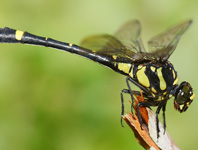Abstract
A new species of Tyrannomyrmex (Hymenoptera, Formicidae), T. alii sp. nov., is described from the Western Ghats of Kerala State in southern India. This new species can be distinguished from other Tyrannomyrmex species using morphological characters, from T.dux by the petiolar shape, and from T. legatus and T.rex by surface sculpture and pilosity. The gyne of the genus is described for the first time. We provide detailed morphological descriptions of the gyne and worker castes, images from scanning electron microscopy, a key to all four known species of Tyrannomyrmex, and a note on the ecology of this rare genus.
References
Alpert, D.G. (2013) A new species of Tyrannomyrmex (Hymenoptera: Formicidae) from Sri Lanka. Zootaxa, 3721, 286–290.
https://doi.org/10.11646/zootaxa.3721.3.5AntWeb (2017) Available from: https://www.antweb.org/images.do?subfamily=myrmicinae&genus=tyrannomyrmex&rank=ge
nus&project=allantwebants (accessed 11 March 2017)Bolton, B. (2003) Synopsis and Classification of Formicidae. Memoirs of the American Entomological Institute, 71, 1–370.
Borowiec, M. (2007) A new species of Tyrannomyrmex (Hymenoptera: Formicidae: Myrmicinae) from India. Zootaxa, 1642, 65–68.
Esteves, F.A. & Fisher, B.L. (2016) Taxonomic revision of Stigmatomma Roger (Hymenoptera: Formicidae) in the Malagasy region. Biodiversity Data Journal, 4, e8032.
https://doi.org/10.3897/BDJ.4.e8032Fernández, F. (2003) A new myrmicine ant genus from Malaysia with uncertain affinities (Hymenoptera: Formicidae). Zootaxa, 341 (1), 1–6.
https://doi.org/10.11646/zootaxa.341.1.1General, D.M. & Alpert, G.D. (2012) A synoptic review of the ant genera (Hymenoptera, Formicidae) of the Philippines. ZooKeys, 200, 1–111.
https://doi.org/10.3897/zookeys.200.2447Harris, R. A. (1979) A glossary of surface sculpturing. Occasional Papers in Entomology, California Department of Food Agriculture, 28, 1–31.
Holloway, J.D. (1974) The biogeography of the Indian butterflies. In: Mani, M. (Ed.), Ecology and Biogeography in India. Springer, The Hague, pp. 473–499.
https://doi.org/10.1007/978-94-010-2331-3_15Jacquemin, J., Sonet, G., Bourguignon, T., Evans, T.A. & Delsinne, T. (2015) Second record and DNA barcode of the ant Tyrannomyrmex rex Fernández (Hymenoptera: Formicidae: Myrmicinae). Sociobiology, 62, 276–280.
https://doi.org/10.13102/sociobiology.v62i2.276-280Myers, N., Mittermeier, R.A., Mittermeier, C.G., Da Fonseca, G.A. & Kent, J. (2000) Biodiversity hotspots for conservation priorities. Nature, 403, 853–858.
https://doi.org/10.1038/35002501Ward, P.S., Brady, S.G., Fisher, B.L. & Schultz, T.R. (2015) The evolution of myrmicine ants: phylogeny and biogeography of a hyperdiverse ant clade (Hymenoptera: Formicidae). Systematic Entomology, 40, 61–81.
https://doi.org/10.1111/syen.12090Wilson, E.O. (1955) A monographic revision of the ant genus Lasius. Bulletin of the Museum of Comparative Zoology, 113, 1–201.
https://doi.org/10.1086/401086Zryanin, V.A. (2012) A new species of the genus Indomyrma Brown, 1986 (Hymenoptera: Formicidae: Myrmicinae) from Vietnam. Russian Entomological Journal, 21, 223–228.

